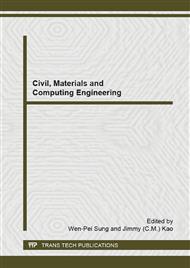[1]
Livada, I., Santamouris, M., Niachou, K., Papanikolaou, N. and Mihalakakou, G. Determination of places in the great Athens area where the heat island effect is observed. Theoretical and Applied Climatology 71 (2002) 219-230.
DOI: 10.1007/s007040200006
Google Scholar
[2]
Parker D S, Barkaszi Jr S F. Roof solar reflectance and cooling energy use: field research results from Florida. Energy and buildings 25 (1997) 105-115.
DOI: 10.1016/s0378-7788(96)01000-6
Google Scholar
[3]
Gray, K. A. and Finster, M. E. The urban heat island, photochemical smog, and Chicago: Local features of the problem and solution. Northwestern University, Department of Civil Engineering (1999).
Google Scholar
[4]
Golden, J. S. The built environment induced urban Heat Island effect in rapidly urbanizing arid regions-A sustainable urban engineering complexity. Environmental Sciences 1 (2004) 321–349.
DOI: 10.1080/15693430412331291698
Google Scholar
[5]
Cao, X., Tang, B., Zhu, H., Zhang, A. and Chen, S. Cooling Principle Analyses and Performance Evaluation of Heat-Reflective Coating for Asphalt Pavement. Journal of Materials in Civil Engineering 23 (2010) 1067-1075.
DOI: 10.1061/(asce)mt.1943-5533.0000256
Google Scholar
[6]
Asaeda, T. and Ca, V. T. Characteristics of permeable pavement during hot summer weather and impact on the thermal environment. Building and Environment 35 (2000) 363-375.
DOI: 10.1016/s0360-1323(99)00020-7
Google Scholar
[7]
Mallick, R. B., Chen, B. L. and Bhowmick, S. Harvesting energy from asphalt pavements and reducing the heat island effect. International Journal of Sustainable Engineering 2 (2009) 214-228.
DOI: 10.1080/19397030903121950
Google Scholar
[8]
Al-Rubaei, A. M., Stenglein, A. L., Viklander, M. and Blecken, G. T. Long-Term Hydraulic Performance of Porous Asphalt Pavements in Northern Sweden. Journal of Irrigation and Drainage Engineering 139 (2013) 499-505.
DOI: 10.1061/(asce)ir.1943-4774.0000569
Google Scholar
[9]
Coleri, E., Harvey, J. T., Yang, K. and Boone, J. M. Micromechanical investigation of open-graded asphalt friction courses' rutting mechanisms. Construction and Building Materials 44 (2013) 25-34.
DOI: 10.1016/j.conbuildmat.2013.03.027
Google Scholar
[10]
Spinnler M, Winter E R F, Viskanta R. Studies on high-temperature multilayer thermal insulations. International Journal of Heat and Mass Transfer 47 (2004) 1305-1312.
DOI: 10.1016/j.ijheatmasstransfer.2003.08.012
Google Scholar
[11]
Wang S, Wang S, Chen J, et al. Method and pavement structure for protecting highway subgrade in frozen soil area: U.S. Patent Application 12/989, 782[P]. (2009).
Google Scholar
[12]
Wang, S., Zhu, Q., Duan, Y. and Shang P. Unidirectional Heat-Transfer Asphalt Pavement for Mitigating the Urban Heat Island Effect. Journal of Materials in Civil Engineering 26 (2014) 812-821.
DOI: 10.1061/(asce)mt.1943-5533.0000872
Google Scholar
[13]
Gui J, Phelan P E, Kaloush K E, et al. Impact of pavement thermophysical properties on surface temperatures. Journal of Materials in Civil Engineering 19 (2007) 683-690.
DOI: 10.1061/(asce)0899-1561(2007)19:8(683)
Google Scholar
[14]
Synnefa A, Dandou A, Santamouris M, et al. On the Use of Cool Materials as a Heat Island Mitigation Strategy. Journal of Applied Meteorology & Climatology 47 (2008) 846-2856.
DOI: 10.1175/2008jamc1830.1
Google Scholar
[15]
Lin, T. P., Ho, Y. F. and Huang, Y. S. Seasonal effect of pavement on outdoor thermal environments in subtropical Taiwan. Building and Environment 42 (2007) 4124-4131.
DOI: 10.1016/j.buildenv.2006.11.031
Google Scholar
[16]
Luca, J. and Mrawira, D. New measurement of thermal properties of superpave asphalt concrete. Journal of materials in civil engineering 17 (2005) 72-79.
DOI: 10.1061/(asce)0899-1561(2005)17:1(72)
Google Scholar
[17]
Li, H., Harvey, J. and Jones, D. Multi-dimensional transient temperature simulation and back-calculation for thermal properties of building materials. Building and Environment 59 (2012) 501-516.
DOI: 10.1016/j.buildenv.2012.09.019
Google Scholar
[18]
Liu, X., Wu, S., Ye, Q., Qiu, J., and Li, B. Properties evaluation of asphalt-based composites with graphite and mine powders. Construction and Building Materials 22 (2008) 121-126.
DOI: 10.1016/j.conbuildmat.2006.10.004
Google Scholar
[19]
García, A., Norambuena-Contreras, J. and Partl, M. N. 2013. Experimental evaluation of dense asphalt concrete properties for induction heating purposes. Construction and Building Materials 46 (2013) 48-54.
DOI: 10.1016/j.conbuildmat.2013.04.030
Google Scholar
[20]
Feng, D., Yi, J. and Wang, D. Performance and Thermal Evaluation of Incorporating Waste Ceramic Aggregates in Wearing Layer of Asphalt Pavement. Journal of Materials in Civil Engineering 25 (2013) 857-863.
DOI: 10.1061/(asce)mt.1943-5533.0000788
Google Scholar


